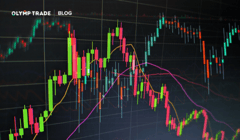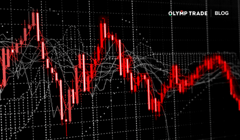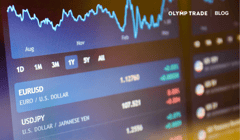
Online trading is best known for trading currencies. This article explains the basics of it and provides useful tips on how to best trade currencies.
Contents
- Main Features of the Currency Exchange
- Fundamental Tips on Currency Trading
- Fundamental Tips on Cryptocurrency Trading
Interact with the dashed blue word and green spot on images to get additional details and explanations.
More details on the visuals will be here.
A term definition or explanation will be here.
Main Features of the Currency Exchange
We may buy currencies when we travel, save money, or earn extra income. Commercial organizations make transactions both in their functional and foreign currencies. Central banks use foreign currencies to hold their reserves and conduct currency interventions.
Nowadays, buying and selling foreign currencies is much simpler than before. Similarly, speculative transactions have become more accessible and available to the public.
A big part of foreign exchange transactions falls on the OTC Forex market which emerged in the 1970’s in the aftermath of the abolition of the Bretton Woods Agreement.
As Forex is a decentralized market, it is hard to find readily available information about what exactly is happening in it. In this respect, the publications of The Bank for International Settlements, or BIS, with the periodically collected statistics on operations on the Foreign Exchange, are useful.
For example, the latest Triennial Survey released by the BIS in 2019 says that most of the transactions in the market fall on foreign exchange swaps go second, and outright forwards are in third place. The total volume of daily transactions exceeds $6 trillion. This figure is greater than the GDP of Japan, Germany, or the UK and is nearly a half of the annual GDP of the entire Eurozone.

The above chart clearly shows the order in which currencies are most popular on FOREX. The top three are the US dollar (USD), the European euro (EUR), and the Japanese yen (JPY).
Trading on the OTC Forex market is done with the help of currency pairs, such as USD/JPY, NZD/USD, etc. The way they are composed and denoted is defined by the International Standardization Organization (ISO) standard #4217. For example, USD/NZD would be an incorrect way to denote the currency pair as the ISO says it should be NZD/USD, and not the other way around.
According to this research, EUR/USD is the most popular currency pair and accounts for the majority of all Forex transactions. Quotes essentially reflect the current agreement of all market participants, sellers, and buyers regarding the valuation. For example, if the EUR/USD quote is 1.04000, it means one will pay 1.04000 USD to buy 1.00 EUR.
A currency pair consists of two parts.
The currency that comes first in a currency pair is called the base currency, or the transaction currency.
The second currency in a pair is the quote currency, or the counter currency, and it is used to determine the value of the base currency.
For example, in the EUR/USD pair, EUR is the base currency and USD is the quote currency. In USD/JPY, USD comes first, so it is the base currency, and JPY is the quote currency.
If USD is the base currency, this is called a direct quotation, and if USD is in the second place in the pair, it is called an indirect quotation.
Also, there are currency pairs without USD, such as EUR/AUD or CAD/CHF. The rates of such pairs are called cross-rates, but they are still calculated using the USD. For example, in order to calculate the EUR/AUD rate, the rates of two currency pairs EUR/USD and AUD/USD are used. Almost all currency pairs of developed economies have the USD and belong to the majors, or the most commonly used currencies for trading. These are EUR/USD, GBP/USD, USD/JPY, USD/CAD, AUD/USD, NZD/USD, and USD/CHF.
Imagine trading the EUR/USD. Let's say, we have US dollars on our account, and we want to buy the European currency, the euro. The Key rate in Europe is 0% per annum, while it is 1% in the US. Thus, when buying euros for US dollars, we sort of borrow money at 1% and place it at 0%. In this scenario, if we do not close our position and do not sell the euro within a year, then we will have a loss of 1%. If we have euros and buy US dollars for them, taking a short position on the EUR/USD pair, then, on the contrary, we borrow money at 0% and place it at 1%. In the latter scenario, we will receive an additional 1% of income. In the FOREX market, this is called a swap. Recalculated daily, swaps can either increase the size of our profit or reduce it.
As the foreigh exchange market is huge, there are two key aspects that traders need to be aware of.
Multipliers Help Access the Market’s Large Trading Volumes
Operations in the FOREX market are done in lots. As trading in lots means huge currency volumes, private traders need to use leverage. Leverage, or multipliers, increase both traders’ risks and profit opportunities.
Fundamental and Technical Analysis are Both Required
Key Forex participants are central, commercial and investment banks, pension funds, insurance companies, and other institutions. Their objectives are mostly far from speculation. While they decide whether to buy or sell a currency based on fundamental factors, these decisions often determine the global market trends. Therefore, in addition to technical analysis, traders need to have an understanding of fundamental factors behind currency movements.
What are Technical and Fundamental Analysis?Fundamental Tips on Currency Trading
Countries’ Key Rates Affect Their Currency Pairs’ Trends
In large time frames, the currency of a country with a higher key rate usually grows.
The behavior of the EUR/USD in the 2000’s is a good example. The head of the US FRS, Alan Greenspan, was trying to keep the US key rate close to zero for a long time. That was mainly because most US Fed policymakers were convinced that the market would equalize everything on its own as per the laissez-faire principle. As a result, EUR/USD was growing for as long as such a policy was held.

As a consequence, the implementation of such a loose monetary policy led to disastrous consequences. The "cheapness" of credit funds made it possible for consumers with no financial stability to take on additional credit obligations. The situation was complicated by the fact that Wall Street began to actively use a tool called securitization, turning bank debts into bonds and offering them to investors.
In order to assess how reliable bonded loans are, they are assigned a certain rating. In the US, there are 3 major rating agencies, Fitch, Moody's, and Standard & Poor's.
Initially, ratings were assigned depending on the degree of reliability of mortgage loans under which bonds were issued. Later, however, subprime bonds were issued for loans of lower reliability. Within such releases, the ratings were mixed, meaning “good” loans were mixed with “bad” ones. This allowed the issue to be assigned a higher rating and be sold to investors. Basically, a huge bubble was inflated in the market due to a long period of low interest rates.
Later on, as the subprime mortgage crisis began in the US, the rates were raised. As a result, the EUR/USD trend changed.
At the start of the COVID-19 pandemic, the US Federal Reserve also resorted to lowering the interest rate from 1.75% down to 0.25%. At the same time, it launched the QE program. As a result, the US dollar began to decline against other currencies. For example, the GBP/USD currency pair rose from 1.20000 to 1.42000.

The Bank of England also lowered its key rate from 0.75% to 0.1% since the beginning of the pandemic. Later, however, this led to a rather strong acceleration of inflation in the country. As a result, the Bank of England was one of the first central banks of the developed economies that started monetary tightening. On December 12, 2021, it raised the rate to 0.25% and kept gradually raising it in subsequent meetings. By that time, the US Fed representatives began to declare the need to reduce QE and tighten policy too. In fact, the Fed acted more aggressively in that direction, and that led to the devaluation of the GBP against the USD. Eventually, GBP/USD dropped from 1.40000 to 1.25000, while EUR/GBP continued to decline.

A Country’s Exports and Imports Affect Its Exchange Rate
Whether a country is export or import oriented affects its currency exchange rate.
For example, if a country makes income mainly through exports, it won’t have much benefit from the strength of its currency. On the contrary, its central bank will either lower rates or make currency interventions to weaken its currency and apply downward pressure on its exchange rate.
“Resource economies” are an example of such countries. These export more than they import and are, thus, net exporters. Among the developed countries, Australia is such an economy. With a positive trade balance since 2018, it has been a net exporter. Almost 40% of its exports are ores, slag, and ash, with mineral fuels such as oil, taking more than 25%. It is beneficial for Australia to keep its key rate as low as possible because that supports its exports. Since 2015, the Australian central bank has been consistently reducing the key rate. Only in the face of rising inflation did the RBA go for monetary tightening, and the rate is now 0.35%. Due to low rates, AUD/USD has mostly been in a downtrend for quite a long time. From 2011 to 2022, the pair dropped from 1.10600 to 0.78000, or almost 30%.
Investors Demand Safe-haven Currencies in Hard Times
Safe-haven currencies are currencies that are considered most attractive to investors during crises due to their expected fundamental stability. CHF and JPY are among the primary ones as these are the currencies of developed economies. If investors see or expect increased uncertainty and unfolding of global economic problems, they will shift funds invested in risky assets such as stocks or high-risk bonds into safer assets.
In order to understand this feature of the foreign exchange market, you need to imagine the world of finance as an ocean. Just as in the ocean, periodic tides are accompanied by backflows, so in the world of finance. If there are problems in the economy, the mass of money that is considered as risky assets such as stocks or high-risk bonds begins to flow into other assets.
Showcasing this logic, the US stock indices presented weak performance in the crisis years of 2008-2009. On the other hand, those were high-performance years for the Japanese yen, which made the USD/JPY pair decline.

Fundamental Tips on Cryptocurrency Trading
Cryptocurrencies have recently become a natural extension of the Forex market. What is cryptocurrency? The fundamental difference between cryptocurrencies and fiat currencies is that cryptocurrencies are not issued by a particular central bank. Therefore, they are not tied to any country in the world. This makes fundamental analysis difficult.
Two of the most popular cryptocurrencies are Bitcoin, with a market capitalization of almost $600 billion, and Ethereum with a market capitalization of over $250 billion. In addition to these "classic" cryptocurrencies, there are stablecoins. The key stablecoins are Tether (USDT), with a market capitalization of almost $80 billion, Binance Coin (BNB), and USD coin (USDC) with a market capitalization of $50 billion.
Despite the fact that the cryptocurrency market is quite developed, the risks of trading are very high. One of the most striking examples was the situation in early 2022 with the LUNA cryptocurrency, which was pegged to the UST stablecoin. Due to a complex scheme of arbitrage operations, a strong collapse happened both for LUNA and for the stablecoin UST, which caused a chain of sales in all cryptocurrencies with the total drawdown of about 30%.
Also, the cryptocurrency market is often subject to manipulation in cases when a group of large participants, often called "whales", dramatically affect a cryptocurrency's price trend.
At the same time, recently, there has been a debate around Bitcoin becoming an alternative to Gold as a protective asset. The fact is that cryptocurrency is not subject to inflation in the classical sense of the word and, therefore, can be theoretically used as a means for accumulating savings.
This means that traders have to be careful investing in cryptocurrencies. In the meantime, trading on them may be very profitable. On Olymp Trade, you can trade on the primary cryptocurrencies such as Bitcoin, Ethereum, and Litecoin. Also, in the Indices section of the Fixed Time Trades mode, you will find the Basic Altcoin Index.
Trade Currencies on Olymp TradeSpeculative transactions generally refer to trading currencies with the purpose of generating income instead of doing business, regulating the exchange rate, or accumulating reserves with them.
The foreign exchange market, Forex, or simply FX is a global marketplace for exchanging national currencies.
Currency swaps involve exchanging cash flows generated from two different currencies to hedge against exchange rate fluctuations.], transactions in the f[spot market]=[Spot market is where financial instruments such as commodities, currencies, and securities are traded for immediate delivery.
An outright forward, or currency forward, is a currency contract that locks in the exchange rate and a delivery date beyond the spot value date. It is the simplest type of foreign exchange forward contract that protects an investor, importer, or exporter against exchange rate fluctuations.
Gross domestic product (GDP) is the total monetary or market value of all finished goods and services produced within a country's borders in a specific period.
Currency pairs are the national currencies from two countries coupled for trading in the foreign exchange marketplace.
A quote is the last price at which an asset was traded. Also, it is the most recent price that a buyer and seller agreed upon and at which some amount of the asset was transacted.
The key rate is the specific interest rate that determines bank lending rates and the cost of credit for borrowers.
One lot is the number of units of a financial instrument that is traded on an exchange, usually equal to 100,000.
Leverage refers to the use of debt, or borrowed funds, to amplify returns on an investment.
Country’s key rate determines the lending rates for banks and the cost of loan for borrowers.
The Federal Reserve System (FRS), or the Fed, is essentially the US central bank.
Securitization is the procedure where an issuer designs a marketable financial instrument by merging or pooling various financial assets into one group.
Quantitative easing (QE) is a form of unconventional monetary policy in which a central bank purchases longer-term securities from the open market in order to increase the money supply and encourage lending and investment.
Fiat money is a government-issued currency that is not backed by a commodity such as gold.
Fundamental analysis is a method of determining an asset’s real or "fair market" value.
Stablecoins are cryptocurrencies that are pegged to fiat currencies and whose rate is being stabilized this way.
Altcoins are all cryptocurrencies other than Bitcoin.











